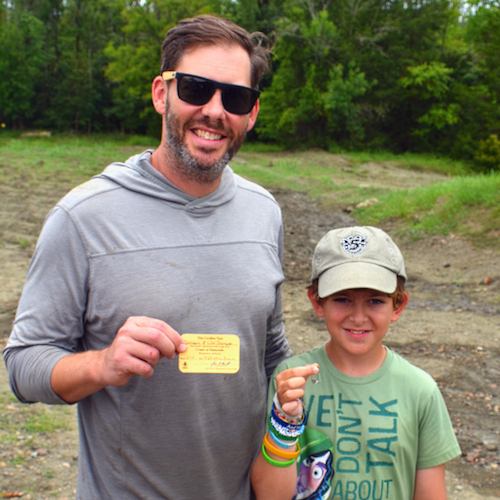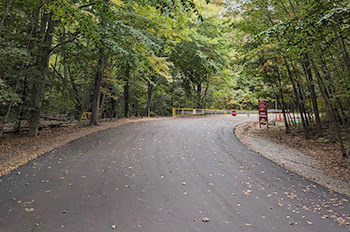Visitor Finds 2.30-Carat Diamond at Arkansas’ Crater of Diamonds State Park

On Friday, September 27, a guest visiting Arkansas’ Crater of Diamonds State Park found a 2.30-carat white diamond in the park’s 37.5-acre diamond search area. This is the third diamond over two carats registered this year and the second-largest diamond registered in 2024.
Eager for the day, the finder arrived at the park when the doors opened at 8 a.m. They rented a basic kit from the park’s Diamond Discovery Center and started out wet sifting, a searching method that involves washing dirt from diamond-bearing gravel through screens of graduated sizes in water. After a few hours of no luck, the guest decided to try surface searching, stating, “If I find a diamond today, it will probably be right here on the surface.”
Many of the park’s largest diamonds are found on the surface. “We periodically plow the search area to loosen the diamond-bearing soil and promote natural erosion,” Assistant Park Superintendent Waymon Cox said. “As rain falls on the field, it washes away the dirt and uncovers heavy rocks, minerals and diamonds near the surface.”
The conditions for surface searching on September 27 were ideal. Not only was it a beautiful sunny day, allowing the sunlight to hit a diamond just right, but the search area had recently been plowed and had received rainfall just two days before.
While walking just west of the covered North Wash pavilion, the guest spotted something sparkling on top of the ground. “From far away it shined so clearly,” they said. “I thought it might be a piece of trash or a bug; it was so much shinier than anything else out there.”
Once the guest walked over and picked it up, they quickly realized it was not a bug or a piece of trash, but a glimmering stone. They stuck the gem in their pocket and had it checked by park staff at the Diamond Discovery Center before leaving for lunch.
Park Interpreter Sarah Reap was at the rock and mineral identification counter when the finder brought their stone up and calmly laid it on the desk. “Even after a few years of working here, I am still surprised when a finder pulls a large diamond out of their pocket so nonchalantly.” Reap said. Moments later, she confirmed it to be a diamond weighing over two carats.
The silvery-white gem has a round, pitted surface and is about the size of a pencil eraser. At first glance, the diamond appears brown, but closer inspection reveals numerous inclusions. These tiny imperfections affect how light passes through the diamond. While the center looks dark brown, the outside of the diamond is clear white.
White diamonds are closest to a pure carbon crystal, while brown diamonds at the Crater of Diamonds State Park are caused by plastic deformation, a structural defect that causes them to appear brown throughout. Almost all natural diamonds have inclusions or blemishes that affect their appearance.
As of this writing, 548 diamonds have been registered by park guests in 2024, weighing more than 82 carats. An average of one to two diamonds are found each day.
Quick Facts about Crater of Diamonds State Park
Diamonds come in all colors of the rainbow. The three most common colors found at Crater of Diamonds State Park are white, brown and yellow, in that order.
In total, over 75,000 diamonds have been unearthed at the Crater of Diamonds since the first diamonds were discovered in 1906 by John Huddleston, a farmer who owned the land long before it became an Arkansas State Park in 1972.
The largest diamond ever discovered in the United States was unearthed in 1924 during an early mining operation on the land that later became Crater of Diamonds State Park. Named Uncle Sam, this white diamond with a pink cast weighed 40.23 carats. It was later cut into a 12.42-carat emerald shape. Uncle Sam is now part of the Smithsonian’s mineral and gem collection and can be seen at the National Museum of Natural History.
Another well-known diamond from the park is the Strawn-Wagner. Found in 1990 by Murfreesboro resident Shirley Strawn, this 3.03-carat white gem was cut into a round brilliant shape weighing 1.09 carats. It graded as ideal cut, D-colorless, and flawless and was set in a platinum and 24-carat gold ring. In 1998, the state of Arkansas purchased this diamond for $34,700 in donations and placed it on permanent display at the park visitor center.
Crater of Diamonds State Park
Located on Arkansas Highway 301 in Murfreesboro, Arkansas, Crater of Diamonds State Park is one of the only places in the world where the public can search for real diamonds in their original volcanic source. The park is open from 8 a.m. to 5 p.m. daily (except New Year’s Day, Thanksgiving, Christmas Eve afternoon and Christmas Day).
Arkansas State Parks
Arkansas State Parks is a division of the Arkansas Department of Parks, Heritage and Tourism. Arkansas state parks and museums cover 55,006 acres of forest, wetlands, fish and wildlife habitat, outdoor recreation facilities, and unique historic and cultural resources. Established in 1923, Arkansas State Parks preserve special places for future generations, provide quality recreation and education opportunities, enhance the state’s economy through tourism and provide leadership in resource conservation. Connect with ASP on Facebook, Instagram and Twitter, and visit ArkansasStateParks.com and ArkansasStateParks.com/media to learn more.
Arkansas Department of Parks, Heritage and Tourism
The Arkansas Department of Parks, Heritage and Tourism protects and promotes our state’s natural, cultural and historic assets, contributing to a thriving economy and high quality of life. It is made up of three divisions: Arkansas State Parks, Arkansas Heritage and Arkansas Tourism.







